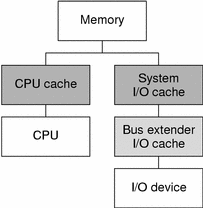Cache
Cache is a very high-speed memory that sits between the CPU and the system's main memory (CPU cache), or between a device and the system's main memory (I/O cache), as shown in Figure 8–1.
Figure 8–1 CPU and System I/O Caches

When an attempt is made to read data from main memory, if the associated cache determines whether it contains the requested data, it quickly satisfies the request. If the cache does not have the data, it retrieves the data from main memory, passes the data on to the requestor, and saves the data in case that data is requested again.
Similarly, on a write cycle, the data is stored in the cache quickly and the CPU or device is allowed to continue executing (transferring). This takes much less time than if the CPU or device had to wait for the data to be written to memory.
With this model, after a device transfer has been completed, the data can still be in the I/O cache but not yet in main memory. If the CPU accesses the memory, it might read the wrong data from the CPU cache. To ensure a consistent view of the memory for the CPU, the driver must call a synchronization routine to flush the data from the I/O cache and update the CPU cache with the new data. Similarly, a synchronization step is required if data modified by the CPU is to be accessed by a device.
There might also be additional caches and buffers between the device and memory, such as caches associated with bus extenders or bridges. Use ddi_dma_sync(9F) to synchronize all applicable caches.
- © 2010, Oracle Corporation and/or its affiliates
